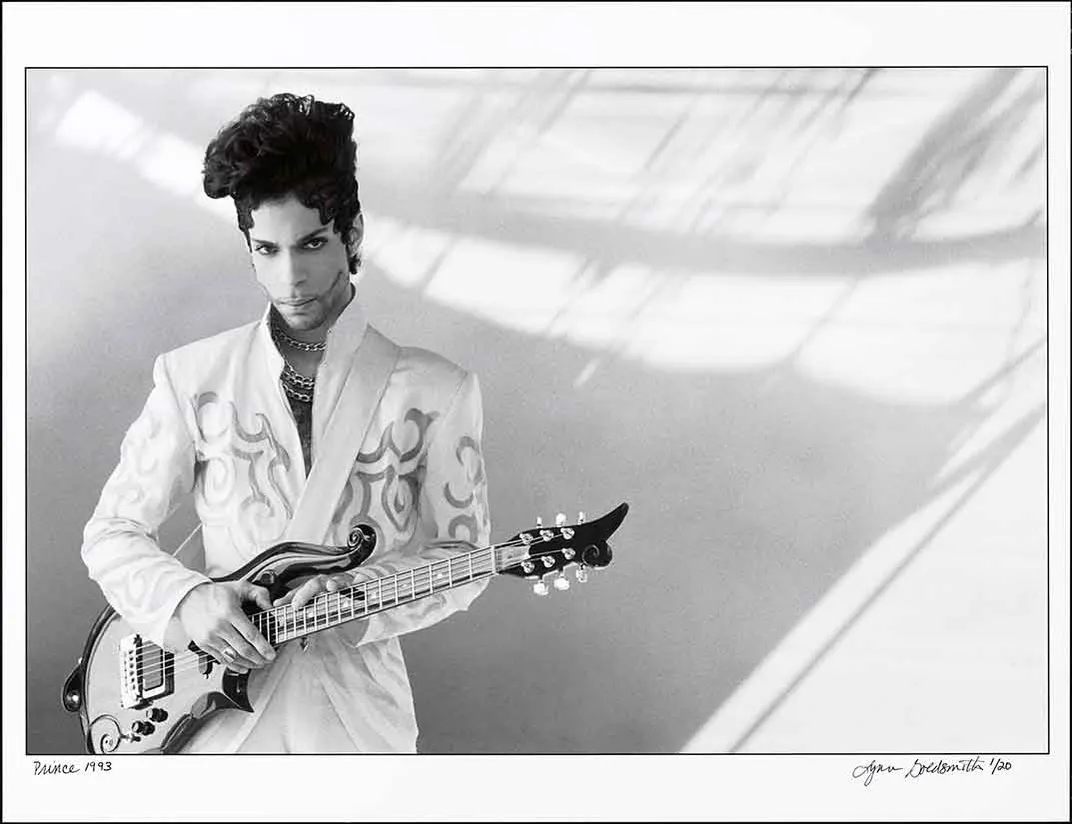Beyond Raspberry Berets: What Prince Left Behind
From portraits to guitars, The Artist’s legacy lives on at the Smithsonian
/https://tf-cmsv2-smithsonianmag-media.s3.amazonaws.com/filer/1d/ae/1dae6f1a-dff2-4fac-880b-b9e6849a70c9/nmah941824web.jpg)
If you want to talk about Prince, you could talk about his five No. 1 singles. Or his epic contract disputes with more than one label. Or his bevy of protégés. Or his supposed archive of thousands of unreleased songs. Or the fact that he briefly changed his name to a symbol. Anything to avoid talking about the fact that the music icon died today at age 57.
Others can assess the overall legacy of Prince Rogers Nelson, who was undeniably one of the greatest pop music composers and artists of all time. But for a sense of the artist’s true passion—his music—you need only glimpse into the collections of the Smithsonian Institution itself.
Portraits and possessions of Prince can be found in the National Portrait Gallery, where his visage was featured in the 2014 exhibition exploring “American Cool,” and the soon-to-be-opened National Museum of African American History and Culture. But perhaps the most evocative is a guitar designed especially for Prince’s over-the-top performances: a custom-made yellow cloud guitar in the collection of the National Museum of American History. (The guitar will be on view April 26-Sept. 5, 2016.)

First seen on film in the 1984 movie Purple Rain, Prince’s choice cloud guitars were built by David Rusan and Barry Haugen at the Minneapolis firm Knut-Koupee Enterprises, Inc. A white cloud was reportedly destroyed at the last gig played by Prince and the Revolution, but the end of that band didn’t calm Prince’s love of clouds. The cloud held in the collections of the American History Museum was made in 1989, just in time for Prince’s out-there Diamonds and Pearls era, which featured a new band, the New Power Generation, and plenty of sexually charged songs to go along with Prince's not-so-slightly suggestive guitar.
Kevin Strait, historian and museum specialist at the National Museum of African American History and Culture, agrees. Prince’s sound, he says, “was unique enough to draw in multiple audiences,” making his career one that was both deeply rooted in African-American musical history and entirely its own. He notes that one of the museum's inaugural exhibitions, "Musical Crossroads," will contain a tambourine played by the artist, as well as rare concert footage and photographs. Prince’s legacy is one of many iconic objects, Strait notes. “There are so many iconic objects like his boots and the Purple Rain motorcycle that would speak to millions of people,” he says.
So what should we talk about when we talk about Prince? It turns out that it’s almost impossible to skirt the legacy—even moments after his death was announced.
“Identifying what made him so unique is almost a futile exercise,” says Strait. “He incorporated so many different influences and fused together so many sounds and made something creative and unique virtually every time he recorded. That’s a testament to the scope of his genius and the scope of his vision as an artist.”
Looking at the artifacts he left behind only tells part of the story—but it serves as a good starting point to honoring the passing of a legend.
Editor's Note, April 23, 2016: Prince’s cloud guitars were built by David Rusan and Barry Haugen.
The National Portrait Gallery will display the 1993 photograph of Prince Rogers Nelson (1958-2016) by Lynn Goldsmith through June 1, 2016. The yellow-cloud electric guitar will be on view at the National Museum of American History beginning April 26 through September 5, 2016.
/https://tf-cmsv2-smithsonianmag-media.s3.amazonaws.com/accounts/headshot/erin.png)
/https://tf-cmsv2-smithsonianmag-media.s3.amazonaws.com/accounts/headshot/erin.png)